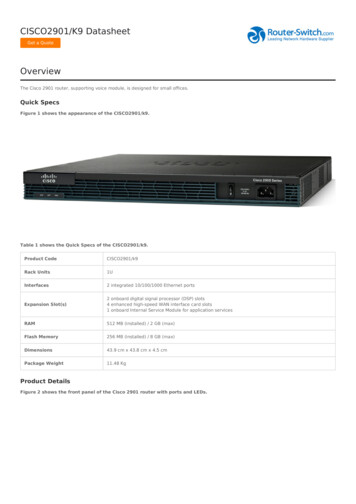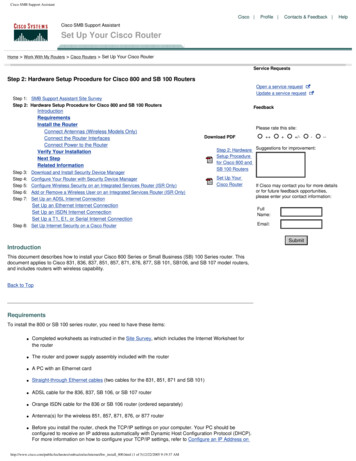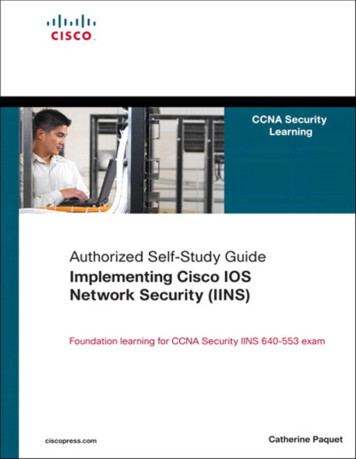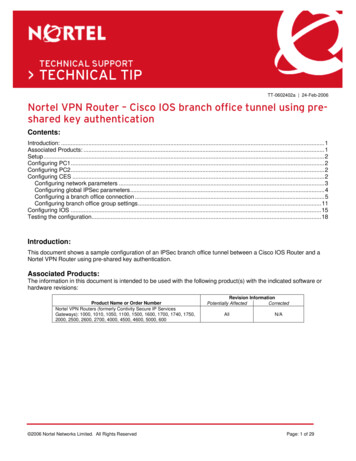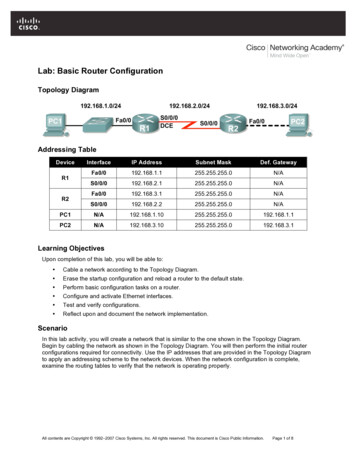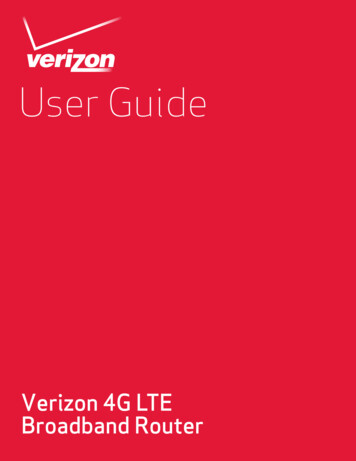
Transcription
ALLYSA LARASATI et al: VIRTUAL ROUTER CISCO PERFORMANCE ANALYSIS ON QEMU HYPERVISOR . .Virtual Router Cisco Performance Analysis on QEMU Hypervisor with Mechanismof Increasing the Number of Routers and Traffic LoadsAllysa Larasati 1, Doan Perdana 2, Gustommy Bisono 3School of Electrical EngineeringTelkom UniversityBandung, ommybisono@telkomuniversity.ac.idAbstract - Network Function Virtualization, NFV, aims to accelerate the implementation of new network services to support businessstrategies and revenue growth for the telecommunications sector in particular. In general, NFV aims to replace the function of theexisting physical router device into a virtual router device and can be run on any virtualization server. In this study, a combination ofCisco virtual routers are tested on a virtualization platform for: throughput, packet loss, jitter and scalability as additional networkhops. The virtualization platform used is a type 2 hypervisor, QEMU (Quick EMUlator), because it is open source and widely used inboth educational and enterprise environments. Our results show: i) throughput increases with traffic volume, ii) link speed betweenhost and router has a maximum rate of 1000 Mbps and a maximum recorded throughput of 778.6 Mbps, iii) the jitter parameter testranged between 0.026 ms to 0.098 ms and met Cisco standards, iv) packet loss parameter was 1%, v) the packets lost ranged from0% to 2,471% caused by virtual links created by qemu and the virtual network interface cards, vi) for scalability, the more networkhops the lower the performance.Keywords - Virtualization, Hypervisor, Network Function Virtualization, QEMUvirtual router images as VNF. The server now, can be inphysical form or virtual server provided by many cloudproviders such as Google Cloud, Digital Ocean, and others.I. INTRODUCTIONAlong with the times, technology also evolved over time,including the very rapid development in thetelecommunications industry in Indonesia. This developmentis inevitable and made the previous one in the form ofhardware devices converted into software tools and still havethe same function. In addition, this makes the operatingsystem that normally runs in hardware turns into an operatingsystem that runs virtually. And raises a new paradigm in thefield of networking, namely Network Function Virtualization(NFV).NFV is a concept of network architecture that usesvirtualization technology that virtualizes all network nodesinto building blocks that can be connected to createcommunication services. The NFV Framework based on theEuropean Telecommunications Standards Institute (ETSI)standard has a definition that is a virtualized, software onlyentity in the form of a Virtualized Network Function (VNF)that runs on virtual resources created by virtualization layersof a collection of physical devices that form NFVInfrastructure (NFVI) [1].So far there is no NFV Framework that forms a unifiedfunction as a virtualization layer provider and is able tomanage all running VNFs. Therefore, to simulate the NFVFramework in accordance with ETSI standards there areseveral components needed, namely the server as a physicaldevice, the hypervisor as a provider of virtualization layer,DOI 10.5013/IJSSST.a.20.01.02Fig. 1. Cloud Computing according to NISTBased on research conducted by the market researchcompany NPD Group, explained that Cisco dominates thesale of hyper-converged infrastructure or IT software basedon software defined and virtualizes all elements ofconventional "hardware" systems [2]. Cisco has also issuedseveral virtual routers such as CSR, IOSXR and others. CiscoCSR is one option that can be used to run on a hypervisor witha 10Gbps license.2.1ISSN: 1473-804x online, 1473-8031 print
ALLYSA LARASATI et al: VIRTUAL ROUTER CISCO PERFORMANCE ANALYSIS ON QEMU HYPERVISOR . .proprietary hardware, and the lack of professionals tointegrate services. The concept of NFV (Network FunctionsVirtualization) can be proposed to overcome this problem.NFV changes the way network operators design theirinfrastructure by utilizing virtualization technology thatseparates software from hardware platforms for networks thatprovide faster services [9]. In operator networks, generallyevery network function is usually run by a software withhardware. Software and hardware in its application areintentionally made to be inseparable and depend on eachother. Virtualization can design flexible software. BecauseNFV can run separately with the hardware. And NFV can berun simultaneously.Based on the research conducted by Xiao Xiao Bian in thepaper "Implement a Virtual Development Platform Based onQEMU" explained that QEMU is a fast and portablehypervisor that can accelerate the deployment process [3].QEMU is expected to run and show good performance insimulating Cisco CSR.II. BASIC THEORYA. Cloud ComputingNot something new if we hear about cloud computing inthe digital era like this. Cloud computing is often defined as acloud when we draw an internet network diagram. In general,cloud computing is always associated with virtualization,because all components in cloud computing are virtual. Cloudcomputing is a model consisting of applications, platforms,and infrastructure that is packaged in cyberspace or theinternet where there are services that can be accessed by users/ clients as needed such as Software as a service (SaaS),Platform as a Service (PaaS), Infrastructure as A Service(IaaS)[4].According to the National Institute of Standards andTechnology (NIST) cloud computing is a form of service thatopens opportunities to be present anywhere, providesconvenience, on-demand network access to configurablecomputing resources, which can be quickly implemented andlaunched, with minimal management efforts or by using aservice provider [5]. The following are 3 service modelsaccording to the National Institute of Standards andTechnology (NIST):Fig. 2. NFV Architecture [7]NFV is a concept that was raised to make networkfunctions that can be implemented entirely in software, andthen to run on industry-standard hardware. In general,industry-standard hardware points to public servers (e.g. Intelx86) available on the market along with their features (e.g.Ethernet standard switches). With this concept, a networkfunction (e.g. Session Border Controller) can be distributed tooperators (only) as software. What this operator needs to do,is just doing the installation procedure on their datacenterinfrastructure (just with a standard e.g. rack-mounted /blade-server device that is connected to an Ethernet switch)[6].A1. Infrastructure as a Service (IaaS): IaaS is an ITinfrastructure service provided by cloud computing to clientssuch as storage, memory, processing power, networkingcomponents, dbs. This service is assumed as the client hires avirtual server computer whose specifications can be changedeasily according to client requirements. Clients are allowed toinstall the operating system, storage, create firewalls and loadbalancers as needed and clients can build their ownapplications as desired.A2. Platform as a Service (PaaS): Clients can developapplications using application frameworks or applicationengines extensively and can control these applications. But itcannot control the operating system, hardware, or network.B1. The Advantages of NFV:-A3. Software as a Service (SaaS): The client can use theapplication but cannot create an application, cannot controlthe operating system, hardware, and network. Applicationscan be accessed via Web-browser or Web-based interface.B. Network Function Virtualization, NFVFlexible, extensibleHigh asset utilityCan carry out continuous processes (deploy, upgrade)Separate / eliminate NF dependence on proprietary devicesPure network software (NF) functionUses standard virtualization technologyCan run on commodity / industry-standard hardwareIt is not new if bringing a new service to the networkbecomes increasingly difficult due to the nature of existingDOI 10.5013/IJSSST.a.20.01.022.2ISSN: 1473-804x online, 1473-8031 print
ALLYSA LARASATI et al: VIRTUAL ROUTER CISCO PERFORMANCE ANALYSIS ON QEMU HYPERVISOR . .F. UDP and TCPC. HypervisorHypervisor is a foundation for special virtualization orsoftware that causes various operating systems to runsimultaneously on a computer. Hypervisor or commonlyreferred to as Virtual Machine Monitor (VMM)[8]. In generalthere are two types of hypervisor, first type or Type 1 andsecond type or Type 2.F1. UDP: UDP is a very simple protocol with a minimumoverhead, if a process needs to send a message that isrelatively small and does not put too much importance onreliability, it is appropriate to use UDP [12]. Sending smallmessages using UDP requires less interaction between thesender and recipient than when using TCP or SCTP.Type 1: This type is also called bare-metal architecture, ahypervisor that runs directly on the server hardware used tocontrol and manage user hardware and does not require an OSto run it. Included in this type of hypervisor are IBM LPAR(PR / SM), Citrix XenServer, Xen Cloud Platform, VMWareESX / ESXi.F2. TCP: Transmission Control Protocol (TCP) is a typeof protocol that allows a collection of computers tocommunicate and exchange data within a network. TCP is aprotocol in the transport layer (seven layers of the OSIreference model) that is connection-oriented and reliable [13].F3. Iperf: Iperf is software that functions to measurebandwidth and service quality of a network. so thatmeasurement can be done, the iperf is installed point to point,either on the server or client side. Iperf itself can be used tomeasure performance links from both TCP and UDP [14].Type 2: Hypervisor Type 2 is also called HostedArchitecture, a hypervisor that is installed on the operatingsystem used on the server, so the type 2 hypervisor is in thesecond layer. Included in this type of hypervisor are VMwareGSX Server / Workstation, VirtualBox, VritualPC, KVM.III. SYSTEM DESIGN AND IMPLEMENTATIONA. Flowchart SystemFig. 3. Hypervisor Type 1 (Left) and Type 2 (Right)D. QEMU HypervisorQEMU is included in the type 2 hypervisor and must runan operating system. QEMU is an emulator engine that isopen source, and has two operating modes, that is systemmode emulation and user mode emulation.E. Cisco CSR 1000VThe Cisco Cloud Services Router (CSR) 1000V is a routerin virtual form intended for deployment in a cloud data center.Using industry-leading Cisco IOS Software networks andsecurity features, CSR 1000V enables companies totransparently expand their WAN to external cloud providersand cloud providers hosted to offer enterprise-class networkservices [11].Fig. 4. Flowchart SystemDOI 10.5013/IJSSST.a.20.01.022.3ISSN: 1473-804x online, 1473-8031 print
ALLYSA LARASATI et al: VIRTUAL ROUTER CISCO PERFORMANCE ANALYSIS ON QEMU HYPERVISOR . .In Figure 4 describes the design of a virtual system on avirtual platform using the QEMU hypervisor. In this virtualsystem the scenario that will be done is to design the virtualsystem and then combine it with the topology. In the topologythere is a host server, client host and Cisco Vrouter.B. Implementation Support NeedsThe need to support this design is divided into two types,namely hardware and software.B1. User: In the implementation of this final project, oneuser runs the hypervisor manager application with thefollowing specifications:TABLE I. USER SPECIFICATIONSSpesifikasiUserProcessorIntel Core i5RAM8 GBStorage250 GBspeed1.6 GHzB2. Server: In the implementation of this final project, oneserver from Google Cloud will be used to run the hypervisorand web manager with the following specifications:TABLE II: SERVER SPECIFICATIONSSpesifikasiServerProcessorIntel Xeon Kabylake 8 CoresRAM32 GBStorage500 GB3. Ubuntu 16.04.4. Cisco CSR 1000V Virtual Router license 10Gbps.5. QEMU as a Hypervisor.6. EVE-NG as QEMU web manager.7. iperf and iperf3Fig. 5. Designing a Virtualization SystemD. System TopologyC. Designing a Virtualization SystemThe design process is shown in figure 5.Fig. 6. System TopologyIn this final project the system topology consists of avirtual server, virtual environment, and 2 hosts. The senderhost device is connected in real time with a virtual router, andin it there are virtual router devices and virtual hosts. Hostsender is used to run the hypervisor manager application andretrieve data.DOI 10.5013/IJSSST.a.20.01.022.4ISSN: 1473-804x online, 1473-8031 print
ALLYSA LARASATI et al: VIRTUAL ROUTER CISCO PERFORMANCE ANALYSIS ON QEMU HYPERVISOR . .TABLE III: TABLE OF THROUGHPUT TESTING RESULTIV. ANALYSIS AND RESULTSTaffic (MB) Throughput TCP (Mbps)This chapter discusses the analysis of the test results withpredetermined scenarios and parameters, by implementingCisco VRouter on the Qemu hypervisor. The Ubuntu 16.04operating system is used as the operating system host to runtests on the Qemu hypervisor. Testing using iperf and iperf3applications with the parameters tested are throughput, packetloss, jitter and scalability. Tests on the parameters ofthroughput, packet loss, and jitter are tested by running CiscoVRouter and two hosts as recipients and senders of packetsthat are streamed to Cisco VRouter. Scalability parametersare tested in the same way except that the addition of CiscoVRouter in each test is done. Scalability testing is carried outup to a maximum of three VNF due to limited resources fromthe server used. Each test is carried out 30 times of datacollection and the average is taken.Throughput UDP .600766.633618.533657.833In Fig 8, it can be seen that throughput has increasedaccording to the amount of traffic flowed. The maximum linkbetween host and router has a maximum capacity of 1000Mbps with the maximum throughput recorded is 778.6 Mbps.The limited throughput is caused by the features of thehypervisor, the ability of vCPU to process data, and the abilityof Cisco VRouter software in data buffering. Throughput canbe increased by applying the interface bonding mechanism orcombining two or more different links on the host and router,but Cisco VRouter does not support these features so that themechanism cannot be applied.A. Throughput, Jitter, and Packetloss TestingThis test uses two hosts as a server and client to streamtraffic and one vRouter as a link between the two hosts.Fig. 7. Test Topology Throughput, Jitter, and PacketlossA2. JitterThe iperf tools work by flowing traffic in accordance withthe bandwidth desired by the user so that for testingthroughput, jitter, and packet loss has a large amount of trafficflowed from 100 Mb to 1000 Mb at intervals of 100 Mb. Thisis based on the ability of the vNIC hypervisor link which has amaximum link capacity of 1000 Mbps or commonly calledGigabit Ethernet. Each test is obtained by flowing TCP andUDP traffic from one host to another through Cisco vRouterfor 30 attempts every second.A1. ThroughputFig. 9. Graph of Jitter testing resultsTABLE IV: TABLE OF JITTER TESTING RESULTTraffic (MB)Jitter 377000.0368000.0269000.04110000.027Fig. 8. Graph of throughput testing resultsDOI 10.5013/IJSSST.a.20.01.022.5ISSN: 1473-804x online, 1473-8031 print
ALLYSA LARASATI et al: VIRTUAL ROUTER CISCO PERFORMANCE ANALYSIS ON QEMU HYPERVISOR . .In Figure (4.3) 9, jitter varies with a range of valuesbetween 0.026 ms - 0.098 ms. Based on the jitter standarddetermined by Cisco, the jitter value that can be calculated isjitter 30 ms. Thus, the test jitter value meets the standards setby Cisco and is feasible to run various services such as onlinegaming, VoIP, and real time video streaming services.A3. PacketlossFig. 11. Network scalability testing topologyB1. Throughput Testing of the Number of RoutersFig. 10. Graph of Packetloss testing resultsTABLE IV: TABLE OF PACKETLOSS TESTING RESULTTrafficPacketloss TCPPacketloss 41%100002.471%Fig. 12. Graph of TCP throughput testing results on the number of routersBased on the results of testing TCP throughput, there is nodecrease in throughput results even though the number ofhops increases on the network. In addition, there is amaximum increase in throughput when two vRouter and threemuch different when one vRouter is run.Based on the standards specified by Cisco, the packet lossvalue that can be received to run various services is 1%. Ifyou see the packetloss test results in table IV, the packet lossvalue ranges from 0% - 2,471%. This can be caused by theability of a virtual network interface card (vNIC) on a badQemu hypervisor, or a virtual link between a bad vNIC andcausing very high packet loss.B. Network Scalability TestingThis test is intended to test the quality of the CiscovRouter network when there is an increase in hop or thenumber of vRouter on the network. The parameters that arespecified are throughput, jitter, and packet loss that will becompared when running one vRouter, two vRouter, and threevRouter with the topology in Figure 11 (4.5). The testingscheme for the two vRouter and the three vRouter is done thesame as the test on one vRouter.DOI 10.5013/IJSSST.a.20.01.02Fig. 13. Graph of UDP throughput testing results on the number of routers2.6ISSN: 1473-804x online, 1473-8031 print
ALLYSA LARASATI et al: VIRTUAL ROUTER CISCO PERFORMANCE ANALYSIS ON QEMU HYPERVISOR . .TABLE V: TABLE OF UDP THROUGHPUT TESTING RESULTS ONTHE NUMBER OF ROUTERSTraffic1 vRouter2 vRouter3 .600575.567596.933900618. 533601.900618.8001000657.833647.200620.600Fig. 14. Graph of Jitter testing results on the number of routersTABLE VI. TABLE OF JITTER TESTING RESULTS ON THE NUMBEROF ROUTERSTraffic1 vRouter2 vRouter3 .018Based on the results of the UDP Throughput test, theresulting pattern is similar to the TCP Throughput testing, thatis there is no significant decrease in results even though thenumber of hops increases. The maximum throughput value is657,833 Mbps. This shows that, although the link capacityprovided by the vNIC hypervisor is 1 Gbps, the resultingthroughput is unable to reach or approach its ideal maximumcapacity on both the TCP and UDP protocols. Many factorscan cause this to happen, one of which is the limited ability ofvNIC from Qemu and is unable to produce maximumthroughput. There is no significant degradation in thisparameter. Therefore, throughput is not degraded if thenumber of hops on the network increases to three routers. Ofcourse, the results will be different if the addition is done bymore than three routers.In figure 15 (4.8), the jitter value is maintained and meetsCisco standards which is below 30ms even though there isan additional number of hops on the network. One factor thatcauses the jitter value not to be affected is the absence oftransmission loss that only occurs when the link useselectrical cables or optical cables such as damping andbending. The jitter parameter is the most stable parameter ofthe results and is very good. Although there are additionalhops or routers, the jitter value remains good and is notaffected by the addition of the hop.B2. Jitter Testing of the Number of RoutersTABLE V. TABLE OF TCP THROUGHPUT TESTING RESULTS ONTHE NUMBER OF ROUTERSTraffic(Mb)1001 vRouter(Mbps)99.8102 vRouter(Mbps)99.7733 .133835.2331000766.633873.133829.267B3. Packetloss Testing of the Number of RoutersFig. 15. Graph of Packetloss testing results on the number of routersDOI 10.5013/IJSSST.a.20.01.022.7ISSN: 1473-804x online, 1473-8031 print
ALLYSA LARASATI et al: VIRTUAL ROUTER CISCO PERFORMANCE ANALYSIS ON QEMU HYPERVISOR . .TABLE VII. TABLE OF PACKETLOSS TESTING RESULTS ON THENUMBER OF ROUTERSto the results of scalability testing with the addition of thenumber of hop networks, there is a decrease or degradation ofthe greatest performance in packet loss parameters.Traffic (Mb)1 vRouter2 vRouter3 ed on the results of packet loss testing on the numberof hops shown in the figure and table above, there is a veryhigh packet loss value when three vRouters are executed orwhen the network has a number of three hops. This can occurdue to congestion on one of the links between the three hops.One way that can be done to reduce packet loss is byincreasing the link capacity of each hop, but this cannot bedone due to the limited features of Qemu.[7][8][9][10][11]V. CONCLUSION[12]We conclude that with a maximum ideal link of 1000Mbps the maximum throughput is 778.6 Mbps. Moreover, theresults of testing the jitter parameters, the results are obtainedbetween a range of 0.026 ms. 0.098 ms and meet thestandards specified by Cisco that is 30ms jitter. Based on theresults of the package parameter test results obtained with arange between 0% s.d. 2.471% and has not met the standardset by Cisco, with the packet loss 1%. This is due to theability of virtual devices from QEMU. Meanwhile, accordingDOI 10.5013/IJSSST.a.20.01.02[13][14]Thekkedath, Balamurali., 2013. Network Function Virtualization tructurebrands-of-q1-2017.htm/3X. Bian, "Implement a Virtual Development Platform Based onQEMU," 2017 International Conference on Green Informatics (ICGI),Fuzhou, 2017, pp. 93-97.Sofana, I., 2012. Cloud Computing Teori dan Praktik. Bandung,Informatika.Mell, P. and Grance, T., 2009. Draft nist working definition of cloudcomputing-v15. 21. Aug 2009, 2, pp.123-135Han, B., Gopalakrishnan, V., Ji, L. and Lee, S., 2015. Networkfunction virtualization: Challenges and opportunities for innovations.IEEE Communications Magazine, 53(2), pp.90-97.Eueung Mulyana. “Buku Komunitas SDN-RG”. Bandung. Publishedby GitBookAjimangun Lintang Mas. Perancangan Dan Analisis PerformansiLayanan Iaas Pada Private Cloud Dengan Cloud Platform Cloudstack,2013.European Telecommunications Standards Institute. 2013. NetworkFunctions Virtualisation (NFV); Use Cases. GS NFV 001 00v-series/index.html# stickynav 2I. Sofana, Cisco CCNA & Jaringan Komputer, Bandung: Informatika,20Putra, M.A.P., Perdana, D., Negara, R.M., Performance analysis of datatraffic offload scheme on Long Term Evolution (LTE) and IEEE802.11AH, Telkomnika (Telecommunication Computing Electronicsand Control) , 2017.Riski Muktiarto, N.A., Perdana, D., Negara, R.M., Performanceanalysis of mobility impact on IEEE 802.11ah standard with trafficpattern scheme, International Journal of Communication Networks andInformation Security, 2018.2.8ISSN: 1473-804x online, 1473-8031 print
sale of hyper-converged infrastructure or IT software based on software defined and virtualizes all elements of conventional "hardware" systems [2]. Cisco has also issued several virtual routers such as CSR, IOSXR and others. Cisco CSR is one option that can be used to run on a hypervisor with a 10Gbps license.


